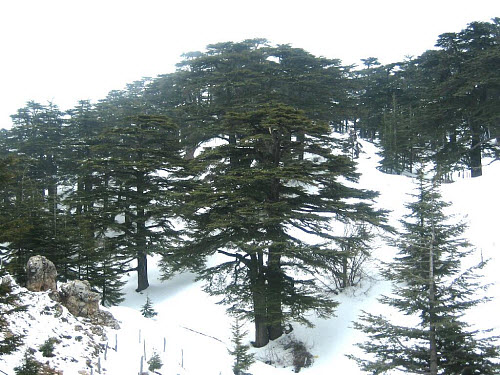What does the Bible say about
cedar trees and cedar wood
Hebrew: אֶרֶז —transliteration: e'rez or erez —meaning: a cedar tree
Greek: kedros (κέδρος )
Latin: cedrus

This is a tree very frequently mentioned in Old Testament scripture (73 verses).
Cedars once grew very abundantly in Israel, and particularly in Lebanon, of which it was “the glory” (Isaiah 35:2; 60:13). They were famous for the height and grandeur.
These Lebanese cedars were particularly stately (Ezek. 31:3-5), long-branched (Psalm 80:10; 92:12; Ezek. 31:6-9), with fragrant aromatic wood (Song of Songs 4:11; Hos. 14:6), and very durable.
The Lebanese mountains were once thick with cedar forests, and they are the symbol and emblem of Lebanon to this day. But over the millennia, they were greatly over cut and neared extinction. Of the truly ancient cedars of Lebanon there remain very few, and they are not standing together. However, there are hundreds of younger trees of ages between 300-400 years.
Four Lebanese cedar trees in the protected Cedars of God area (Kadisha Valley of Bsharre, Lebanon) have reportedly reached a height of 115 feet (35 meters), with trunk girths reaching 39–46 feet (12–14 meters). The spread of the boughs of one notable tree is recorded at 37 yards (approximately 33.8 meters).
Hiram supplied Solomon with cedar trees from Lebanon for various purposes connected with the construction of the Holy Temple and the king’s palace (2 Samuel 5:11; 7:2, 7; 1 Kings 5:6, 8, 10; 6:9-10, 15-16, 18, 20; 7:2-3, 7, 11-12; 9:11, etc.).
Cedar was used often for boards, pillars, and ceilings (1 Kings 6:9-10; 7:2; Jeremiah 22:14), for ship masts (Ezek. 27:5), and for carved images (Isaiah 44:14).
Cedars were used also in the building of the second temple under Zerubbabel (Ezra 3:7).
The great cedar trees are also mentioned in the ancient Epic of Gilgamesh (aka Nimrod), where he uses them to build his city.
The wood was widely used by the Israelites, Phoenicians (fleets of merchant ships), Egyptians, Assyrians, Babylonians, Persians, Romans, Arabs, and Turks. The Egyptians all used cedar resin in their mummification process.
Aromatic cedar wood was used by Israel’s priests in a post-leprosy ceremony.
…the priest shall look, and if the infection of leprosy has been healed in the leper, then the priest shall give a command to take two live clean birds and cedar wood and a scarlet string and hyssop for the one who is to be cleansed. The priest shall also give a command to slaughter the one bird in an earthenware vessel over running water. As for the live bird, he shall take it together with the cedar wood and the scarlet string and the hyssop, and he shall dip them and the live bird in the blood of the bird that was slaughtered over the running water. He shall then sprinkle seven times the one who is to be cleansed from the leprosy and shall pronounce him clean, and he shall let the live bird go free over the open field. The one to be cleansed shall then wash his clothes and shave off all his hair and bathe in water and be clean. …—Leviticus 14:3-8 excerpt
The cedar is often figuratively alluded to in the sacred Scriptures.
“The mighty conquerors of olden days, the despots of Assyria and the pharaohs of Egypt, the proud and idolatrous monarchs of Judah, the Hebrew commonwealth itself, the war-like Ammonites of patriarchal times, and the moral majesty of the Messianic age, are all compared to the towering cedar, in its royal loftiness and supremacy (Isaiah 2:13; Ezek. 17:3, 22-23, 31:3-9; Amos 2:9; Zechariah 11:1-2; Job 40:17; Psalm 29:5; 80:10; 92:12, etc.).” ——William Howse Groser, Scripture Natural History
In the Book of Job, God compares the tail of a behemoth—a great plant-eating dinosaur—to a cedar tree (Job 40:15-19 —see: Are dinosaurs mentioned in the Bible?).
Q & A
- What do we know abou the Phoenician King Hiram of Tyre who provided cedars to King Solomon?
- Answers about ancient Lebanon
- About wood in the Bible
- CARVING—What does the Bible say about it?
- Answers about trees of the Bible
- Answers about plants of the Bible
- Answers about forests in the Bible
- Are dinosaurs mentioned in the Bible?
- DINOSAUR ORIGIN—Where did the dinosaurs come from?
- What is the Book of Job?
- Who is the man Job?
- Who is Nimrod? Was he godly or evil?
- Where is Gilgamesh mentioned on ChristiaAnswers?
- Gilgamesh noted on AnswersInGenesis site
- Gilgamesh on Creation.com site